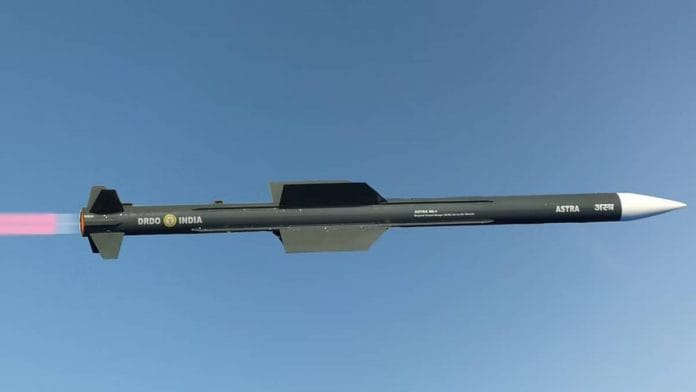New Delhi: With an aim to end decades of Indian reliance on Russian and French air-to-air missiles (AAM), the Indian defence and security establishment is set for the maiden test of the indigenous Astra Mk 2 missile with a 160-km range, ThePrint has learnt.
On Tuesday, the Defence Ministry announced the signing of a deal for the Astra Mk 1 Beyond Visual Range (BVR) AAM and associated equipment, at a cost of Rs 2,971 crore. The Astra Mk 1 missile, for the use of the Indian Air Force and Indian Navy, is being procured from Bharat Dynamics Limited (BDL).
This is the first such indigenous missile to enter the service of the Indian armed forces, which has always depended on Russian (mainly R 73 and R 77) and French (Mica and Meteor) air-to-air missiles.
While the defence establishment remained tight-lipped on the exact number of missiles that have been ordered, sources said it is over 200 and will cater to the Sukhoi Su-30 MKI of the IAF and the MiG-29K of the Indian Navy.
The plan is to integrate the missile on board the MiG-29 of the IAF and Light Combat Aircraft ‘Tejas’ Mk 1 in a phased manner.
While the Astra Mk 1 has a range of about 110 kilometres, sources said the real game-changer will be the next-generation version, which will have a long range of about 160 kilometres.
The Astra Mk 1 missile, which cost about Rs 7-8 crore each and has been developed by Defence Research and Development Organisation (DRDO), has a maximum speed of Mach 4.5 (over 5,500 kmph).
Sources indicated that the test for Mk 2, which will bring back India’s air-to-air combat superiority over Pakistan, will take place soon, or within this month. For the Astra Mk 2, the DRDO has developed a dual-pulse rocket motor to extend the range.
Also read: Was it a missile? Was it BrahMos? India probing Pakistani claim of airspace intrusion
Extending range
ThePrint had in December 2020 reported that the DRDO was working on a longer range version of the Astra missile and would test it mid-2022.
The IAF had an advantage over its Pakistani counterparts during the Kargil battle in 1999, but lost it in 2010 when the longer-range American AMRAAM was deployed by the latter.
The then IAF chief, Air Chief Marshal R.K.S. Bhadauria, had on 28 February 2020 said that the force is looking at regaining the upper hand in air-to-air missile capabilities that was “allowed to slip” amid a “struggle” to acquire missiles in a process that has lasted 15 years.
The IAF chief was referring to the European-manufactured Meteor missiles, which have a range of about 150 km, which are now on board the Rafale fighters.
Plans to have them integrated with other fighters were ditched, however, because the cost was very high, with each missile costing about Rs 25 crore.
Moreover, the European manufacturer of the missile — MBDA — told the IAF that the French-made Mirage 2000 and the Russian Su-30 MKI are not suitable for this missile, because the radars on board these aircraft would not do justice to its capability.
For the Tejas aircraft, MBDA said that the missile can be integrated only when the aircraft is equipped with the indigenous AESA radar, rather than the Israeli one that will be initially used.
Following this, the IAF decided to restrict the Meteor missile to the Rafale and rely on better versions of Astra and Israeli I-Derby for its main firepower.
(Edited by Poulomi Banerjee)
Also read: Why Pralay quasi-ballistic missile, tested by DRDO today, will be a ‘game-changer’ for Army






